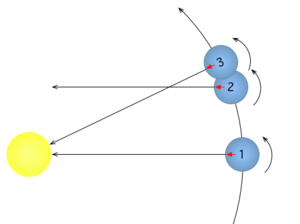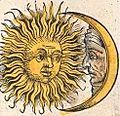Solar time facts for kids

Solar time is a way we measure the passage of time using the Sun's position in the sky. The basic unit of solar time is the day. There are two main types of solar time: apparent solar time (what a sundial shows) and mean solar time (what your clock shows).
Contents
What is Solar Time?
Solar time helps us understand how long a day truly is based on the Sun. Imagine the Sun moving across the sky from morning to night. When the Sun reaches its highest point, that's noon. The time it takes for the Sun to return to that exact same highest point is one solar day.
Apparent Solar Time
Apparent solar time is the time you would read directly from a sundial. It's based on the actual position of the Sun. Because Earth's orbit around the Sun is not a perfect circle, and because Earth's axis is tilted, the length of an apparent solar day changes slightly throughout the year. This means a sundial might run a little fast or slow compared to a regular clock.
Mean Solar Time
Mean solar time is the time we use every day on our clocks. It's an average of all the apparent solar days throughout the year. Imagine a "fake" Sun that moves at a steady speed across the sky. Mean solar time is based on this imaginary Sun. This makes sure that every day on our clocks has exactly 24 hours, even though the real Sun's movement varies a bit.
Why do we use Mean Solar Time?
Using mean solar time makes our lives much simpler. If we used apparent solar time, clocks would constantly need to be adjusted. Trains, planes, and even school schedules would be very hard to keep on time! Mean solar time gives us a consistent and predictable way to measure time.
Solar Day vs. Sidereal Day
You might hear about a "sidereal day" too. A solar day is how long it takes for the Sun to appear in the same spot in the sky again. A sidereal day is how long it takes for Earth to spin exactly once on its axis, relative to distant stars.
Because Earth is always moving around the Sun, it has to spin a little bit more than one full rotation for the Sun to be in the same place. This means a solar day is slightly longer than a sidereal day. A solar day is about 24 hours, while a sidereal day is about 23 hours and 56 minutes.
Images for kids
See also
 In Spanish: Tiempo solar para niños
In Spanish: Tiempo solar para niños



